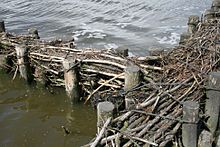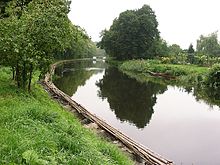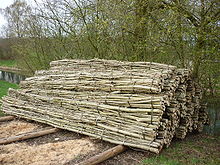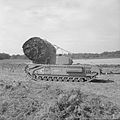Fascine


Fascines (from Latin fascis ; Italian fascio ' bundle ', ' bund ') are cylindrical bundles of sticks or rods a few meters in length, which are primarily used to ward off erosion phenomena or embankment breaks. Accordingly, they are used in particular in the construction of embankments and in hydraulic engineering (for bank or river bed reinforcement as well as for structural improvement and silting ), see also battle (hydraulic engineering) and Wolfsche's hangers . Fascines are also used in the reclamation of land in the tidal flats to build the Lahnungen in order to sediment and silt up the suspended matter transported by the tides by calming the currents .
Fascines buried in a row are also used for drainage .
description
To strengthen embankments, the fascines are nailed to the slope with pegs in a diamond shape. Then they are covered with topsoil . They also act as drainage. Special knives made it easier to make the bundles of brushwood and were therefore also called fascine knives .
During the siege war , fascines were also used to fill castle or other moats in order to enable scaling ladders to be built. Fascine hooks were tools with three iron hooks to tear down the fascine and bulwark cages. Saw-back fascine bayonets were part of the equipment of the engineer troops.
Fascines are also used for temporary dam protection in river regulation . Lowering fascines are used on the underwater . These are filled with stones inside the bundle. The brushwood protects against erosion by the water current. Sediment settles in the spaces in between.
In coastal protection , fascines protect dunes and sandy beaches. They protect against drift and sedimentation of the sand on the leeward side .
Fascines are also used for fortification when reforestation on slopes.
In mining, fascines were sometimes used as a pack in high pressure mountains to cushion any mountain movements behind shaft or tunnel extensions .
Today a large part of the material comes from residual forest wood .
Application example
With the international Rhine regulation for the Fußacher piercing, a fascine bed first had to be created for the dams.
“The fascine bed, consisting of bundles of fascines, as a base for the foreground stones on soft ground, was an urgently needed construction aid. The fascine is a 4 m long and 50 cm thick bundle made of willow or alder wood. The almost consistently poor building ground required a great deal of fascine wood, which was mainly obtained from abroad (Bavaria, Württemberg and Baden). Over 41,000 m³ of fascine wood were used. "
Military use of fascines
In addition to hydraulic engineering, military use has always been an important area of application for fascines. Bundles of brushwood could be made quickly with local material. With their help, the walls of trenches were reinforced to prevent the earth from sliding down. Furthermore, entire artillery positions (batteries) were built with it. To overcome trenches, the bundles were thrown into the trench in large quantities. This method has also proven itself during the First and Second World Wars , with the difference that tanks were used for transport.
It wasn't until the 1980s that British pioneers introduced something new. Especially to be able to cross water-filled trenches, bundles of sturdy pipes are thrown into the trench. This easy-to-transport material is strong enough to even carry tanks. A damming up of flowing water is avoided as a desirable side effect, so that additional drainage can be dispensed with.
literature
- Bergmeister and Kalt (ed.): The Alpine Rhine and its regulation. International Rhine Regulation 1892–1992 . Commission publisher: BuchsDruck und Verlag, Rorschach 1993, ISBN 3-905222-65-5 .
- Johann Samuelersch, General Encyclopedia of Sciences and Arts , p. 11, digitized
- Johann Albert Eytelwein, practical instruction on the construction of the fascine works and the associated systems on rivers and streams , 1813, digitized
- Manual for the officers of the royal Prussian artillery , digitized
Web links
See also
- Fasces , ancient Roman bundle of rods
Individual evidence
- ^ So Johann Christoph Adelung in "Grammatical-Critical Dictionary of High German Dialect", Vienna 1811






